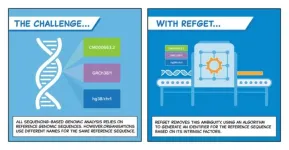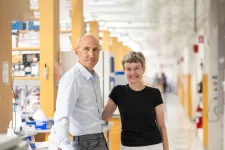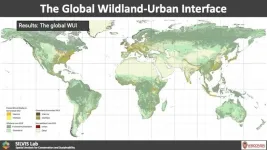(Press-News.org) Research conducted at the University of São Paulo (USP) in Brazil shows that SARS-CoV-2, the virus that causes COVID-19, can infect liver cells (hepatocytes), stimulating glucose production and leading to a condition similar to diabetes (hyperglycemia) in hospitalized patients, even if their blood sugar level was normal before they were admitted to hospital.
An article on the study is published in Proceedings of the National Academy of Sciences (PNAS). The findings describe part of the mechanism used by the virus to infect liver cells and impair glucose metabolism, and point to possible strategies to avert a deterioration in the clinical condition of these patients.
According to the researchers, viral entry into liver cells is partially mediated by cooperation between the proteins GRP78 and ACE2. The latter, known to permit cell invasion by the virus throughout the body, is present on the surface of human liver cells in a low molecular weight isoform instead of the regular one. This is one of the researchers’ novel findings. Previous studies suggested liver cells did not express ACE2.
“Hyperglycemia is a prevalent complication in hospitalized COVID-19 patients that occurs regardless of their diabetes history and is associated with a worse clinical outcome”, the authors write, adding that whether SARS-CoV-2 directly triggers hyperglycemia was previously unknown. They, therefore, set out to discover whether and how the virus infects hepatocytes and increases glucose production, causing hyperglycemia.
Since the start of the pandemic in 2020, diabetes has been considered a risk factor for COVID-19 patients, but the precise reasons have remained unclear. Prior research showed that the risk of death for COVID-19 patients with type 1 diabetes was 3.5 times greater than for patients without the disease. For patients with type 2 diabetes, the risk was twice as great.
“Confirming the link with receptors GRP78 and ACE2 was the cherry on the cake for our study, but the most significant result was that SARS-CoV-2 causes hyperglycemia directly, regardless of corticoid use, stress due to hospitalization, body weight and diabetes. It’s the first time the virus has been shown to cause hyperglycemia directly,” Luiz Osório Silveira Leiria, last author of the article, told Agência FAPESP. Leiria is a professor in the Department of Pharmacology at the University of São Paulo’s Ribeirão Preto Medical School (FMRP-USP).
The study was supported by FAPESP via four projects (20/05040-4, 17/08264-8, 16/00194-8 and 20/04558-0), and was conducted under the aegis of the Center for Research on Inflammatory Diseases (CRID), a Research, Innovation and Dissemination Center (RIDC) established by FAPESP.
Hyperglycemia in type 1 diabetes may occur when the immune system attacks the cells of the pancreas that produce insulin, reducing or eliminating its capacity to secrete the hormone and leading to glucose metabolism imbalance. However, the researchers found that the patients analyzed had no pancreatic damage and therefore investigated their livers. Among other functions, the liver plays a major role in maintaining normal blood sugar levels by regulating glucose production (gluconeogenesis) and storing ingested glucose as glycogen for use when needed.
Long road
A retrospective clinical trial, combined with ex vivo and in vitro assays involving liver cells isolated from patients, showed that SARS-CoV-2 infects hepatocytes by binding to ACE2 and GRP78 receptors and increases production of hepatic glucose.
The study sample comprised 269 patients treated in the intensive care unit of Hospital das Clínicas (HC), the general and teaching hospital complex run by FMRP-USP, and 663 patients admitted with suspected COVID-19 to the Center for Intensive Medicine (CEPETI) in Curitiba, Paraná state, between March and August 2020 and submitted to PCR testing.
The control group consisted of patients with other respiratory diseases, admitted to intensive care in the same period. “We succeeded in obtaining an almost perfect control group, with similar symptoms, negative PCR results and the same hospital environment,” Leiria said.
The analysis of human primary hepatocytes showed that the cells were infected by SARS-CoV-2. “We also analyzed biopsies and found the virus in these hepatocytes. It was replicating in both cases. This was most interesting, mainly because the virus didn’t cause the death of these hepatocytes but used them to replicate and also increased the amount of glucose produced,” he said.
After these results were obtained, their behavior was analyzed in vitro in response to other variants of SARS-CoV-2, such as delta, gamma and omicron, and the outcomes were similar.
To explore possible treatment strategies, the researchers tested compounds capable of inhibiting GRP78 and ACE2. One of the candidates confirmed was metformin, a drug used to treat high blood sugar levels in type 2 diabetes by inhibiting hepatic gluconeogenesis.
“Other studies found that intensive therapy with insulin in the hospital doesn’t necessarily help these patients. A drug like metformin is more effective than insulin. Of course, metformin acts in various ways, but it’s a potential route to provide additional protection for these patients,” Leiria said.
On May 5, 2023, the World Health Organization (WHO) announced that it no longer considered the COVID-19 pandemic a global health emergency after a little more than three years. The pandemic caused trillions of dollars in economic losses and some 7 million deaths worldwide, according to official data. In Brazil, the number of deaths in Brazil reached at least 704,000 and there were some 37.7 million cases of COVID-19, according to the Ministry of Health’s Coronavirus Panel.
Origins
The study began in 2020 when diabetes and obesity were considered the main risk factors for the more severe forms of COVID-19. “The trigger was the insight that this diabetic condition might be aggravated in the hospital,” Leiria recalled. “At the time, a Brazilian article came out showing that the virus replicated more intensely in infected monocytes as more glucose was added to the culture medium.”
He was referring to the discovery that higher levels of blood sugar in diabetic patients are captured by monocytes, a type of defense cell, and serve as a source of additional energy for the virus to replicate more than in a healthy organism. In response to the increased viral load, the monocytes release large amounts of pro-inflammatory cytokines with several effects, including lung cell death (read more at: agencia.fapesp.br/33296).
Last year Leiria’s research group joined a task force led by scientists affiliated with the State University of Campinas (UNICAMP) and FMRP-USP who studied the link between visceral fat (fat around the liver, intestines and other vital organs) and severe COVID-19, concluding that it can contribute more to the severe form of the disease than subcutaneous fat (read more at: agencia.fapesp.br/40233).
In July 2020, another research group, led by the principal investigator for this study, Marcelo Mori, a professor at UNICAMP’s Institute of Biology (IB), was the first to show that SARS-CoV-2 can infect human fat cells and that adipose tissue may be a reservoir for the virus (read more at: agencia.fapesp.br/33729).
About São Paulo Research Foundation (FAPESP)
The São Paulo Research Foundation (FAPESP) is a public institution with the mission of supporting scientific research in all fields of knowledge by awarding scholarships, fellowships and grants to investigators linked with higher education and research institutions in the State of São Paulo, Brazil. FAPESP is aware that the very best research can only be done by working with the best researchers internationally. Therefore, it has established partnerships with funding agencies, higher education, private companies, and research organizations in other countries known for the quality of their research and has been encouraging scientists funded by its grants to further develop their international collaboration. You can learn more about FAPESP at www.fapesp.br/en and visit FAPESP news agency at www.agencia.fapesp.br/en to keep updated with the latest scientific breakthroughs FAPESP helps achieve through its many programs, awards and research centers. You may also subscribe to FAPESP news agency at http://agencia.fapesp.br/subscribe.
END
SARS-CoV-2 infects liver, stimulating glucose production and contributing to severe form of COVID-19
A study conducted at the University of São Paulo and reported in PNAS explains hyperglycemia in hospitalized patients and shows how SARS-CoV-2 causes symptoms similar to those of diabetes
2023-07-19
ELSE PRESS RELEASES FROM THIS DATE:
Research could pave way to greener, more sustainable products made with renewable carbon
2023-07-19
Carbon-based materials have several qualities that make them attractive as catalysts for speeding up chemical reactions. They are low-cost, lightweight and their high surface area provides a good scaffold on which to anchor catalysts, keeping them stable and dispersed far apart, while providing molecules a lot of surface area to work. This makes carbons useful for energy storage and sensors. Over the last 10 years, carbons have been used in electrochemistry to catalyze reactions to make chemicals and fuel cells.
However, ...
Unlocking the power of molecular crystals: a possible solution to nuclear waste
2023-07-19
In a world increasingly concerned about the environmental and geopolitical implications of fossil fuel usage, nuclear energy has resurfaced as a subject of great interest. Its ability to generate electricity at scale without greenhouse gas emissions holds promise as a sustainable clean energy source that could bridge society’s transition away from fossil fuels to a net-zero future. However, nuclear power generation does produce radioactive waste. The safe management of nuclear waste remains a crucial challenge that must be addressed to gain public confidence in this transformative power solution.
Now, a team of University of Houston researchers has come up with an innovative ...
refget v2.0 links the hidden dictionaries of DNA
2023-07-19
A widely-used tool that finds the exact references needed to pinpoint differences in our DNA just got a refresh.
On 17 July, the Standards Steering Committee of the Global Alliance for Genomics and Health (GA4GH) voted to release refget v2.0. With better compatibility for a range of reference genome names, formats, and systems, the new version of refget makes it easier than ever to retrieve verified genomic reference sequences.
A vital infrastructure
You may not even realise that you’re using refget already.
“Almost ...
Do certain amino acids modify the risk of dementia linked to air pollution?
2023-07-19
EMBARGOED FOR RELEASE UNTIL 4 P.M. ET, WEDNESDAY, JULY 19, 2023
MINNEAPOLIS – Higher levels of vitamin B-related amino acids may be linked to the risk of dementia associated with a certain type of air pollutants called particulate matter, according to a study published in the July 19, 2023, online issue of Neurology®, the medical journal of the American Academy of Neurology. The study does not prove that pollution or amino acids cause dementia, but it suggests a possible link among them.
Researchers ...
CHOP and Penn researchers find behavioral economics strategies can help patients quit smoking after a cancer diagnosis
2023-07-19
Philadelphia, July 19, 2023 – Researchers from Children’s Hospital of Philadelphia (CHOP) and the Perelman School of Medicine at the University of Pennsylvania found that cancer patients who continued to smoke after their diagnosis were significantly more likely to receive treatment for tobacco use when “nudges” to provide tobacco treatment were directed at clinicians through the electronic health record. The findings strengthen the case for using behavioral economics, or targeting predictable patterns in human decision-making to overcome ...
Hepatitis cases and heart valve infection deaths tied to early OxyContin marketing
2023-07-19
New Haven, Conn. — Decades after Purdue Pharma began to push physicians to prescribe addictive pain pills, the opioid crisis has been a slow-motion disaster, with overdoses destroying lives and families across the country.
Now, it appears the consequences of those early marketing efforts are even more devastating. In a new study, researchers at the Yale School of Public Health show that infectious disease rates in the United States also climbed as a direct long-term result of the marketing of OxyContin.
By ...
Treatment at the first signs of MS could mean lower risk of disability later
2023-07-19
EMBARGOED FOR RELEASE UNTIL 4 P.M. ET, WEDNESDAY, JULY 19, 2023
MINNEAPOLIS – People who start taking medication soon after the first signs of multiple sclerosis (MS) may have a lower risk of disability later, according to a study published in the July 19, 2023, online issue of Neurology®, the medical journal of the American Academy of Neurology.
MS is a disease in which the body’s immune system attacks myelin, the fatty white substance that insulates and protects the nerves. Symptoms of MS may include fatigue, numbness, ...
Teaching robots to teach other robots
2023-07-19
You’re a poker wizard. A friend knows all about French cuisine. Another friend is a Mozart expert.
The three of you get together and share knowledge about your respective expertise. Each of you leaves learning something from the other two.
People learn a lot by sharing and exchanging information. Can computers do the same with other computers—can robots, in effect, teach other robots how to learn by sharing knowledge?
A team of researchers led by computer science Professor Laurent Itti and one of his Ph.D. students, Yunhao Ge, address this question in ...
Molecular biologists identify framework for understanding RNA editing in a disease-causing parasite
2023-07-19
As molecular biologists at Boston University and as husband and wife, Ruslan Afasizhev and Inna Afasizheva, have worked together for decades. Together, they have published dozens of papers on the mechanics of mitochondrial DNA and RNA in a single-celled, disease-causing parasite called Trypanosoma brucei. Now, years of breakthroughs have led to their latest paper published in Science, which provides a detailed look at a mystifying process called RNA editing and could potentially help treat a deadly disease.
In ...
Picturing where wildlands and people meet at a global scale
2023-07-19
Researchers led by a team at the University of Wisconsin–Madison have created the first tool to map and visualize the areas where human settlements and nature meet on a global scale. The tool, which was part of a study recently published in Nature, could improve responses to environmental conflicts like wildfires, the spread of zoonotic diseases and loss of ecosystem biodiversity.
These areas where people and wildlands meet are called the wildland-urban interface, or WUI for short. More technically, a WUI (pronounced “woo-ee”) describes anywhere that has at least one house per 40 acres and is also 50% covered by wildland ...
LAST 30 PRESS RELEASES:
Manganese gets its moment as a potential fuel cell catalyst
“Gifted word learner” dogs can pick up new words by overhearing their owners’ talk
More data, more sharing can help avoid misinterpreting “smoking gun” signals in topological physics
An illegal fentanyl supply shock may have contributed to a dramatic decline in deaths
Some dogs can learn new words by eavesdropping on their owners
Scientists trace facial gestures back to their source. before a smile appears, the brain has already decided
Is “Smoking Gun” evidence enough to prove scientific discovery?
Scientists find microbes enhance the benefits of trees by removing greenhouse gases
KAIST-Yonsei team identifies origin cells for malignant brain tumor common in young adults
Team discovers unexpected oscillation states in magnetic vortices
How the brain creates facial expressions
Researchers observe gas outflow driven by a jet from an active galactic nucleus
Pitt student finds familiar structure just 2 billion years after the Big Bang
Evidence of cross-regional marine plastic pollution in green sea turtles
Patients with clonal hematopoiesis have increased heart disease risk following cancer treatment
Stem cell therapy for stroke shows how cells find their way in the brain
Environment: Up to 4,700 tonnes of litter flows down the Rhine each year
Maternal vaccine receipt and infant hospital and emergency visits for influenza and pertussis
Interim safety of RSVpreF vaccination during pregnancy
Stem cell engineering breakthrough paves way for next-generation living drugs
California grants $7.4 million to advance gene-edited stem cell therapy for Friedreich’s ataxia
Victoria’s Secret grant backs cutting-edge ovarian cancer research
Research paves the way for safer colonoscopy bowel prep for people with compromised gut health
JMIR Publications and Sweden's National Library announce renewal and expansion of flat-fee unlimited open access partnership for 2026
A new 3D-printed solar cell that’s transparent and color-tunable
IV iron is the cost-effective treatment for women with iron deficiency anemia and heavy menstrual bleeding
Doing good pays off: Environmentally and socially responsible companies drive value and market efficiency
City of Hope and Cellares to automate manufacturing of solid tumor CAR T cell therapy
Short-circuiting pancreatic cancer
Groundbreaking mapping: how many ghost particles all the Milky Way’s stars send towards Earth
[Press-News.org] SARS-CoV-2 infects liver, stimulating glucose production and contributing to severe form of COVID-19A study conducted at the University of São Paulo and reported in PNAS explains hyperglycemia in hospitalized patients and shows how SARS-CoV-2 causes symptoms similar to those of diabetes


